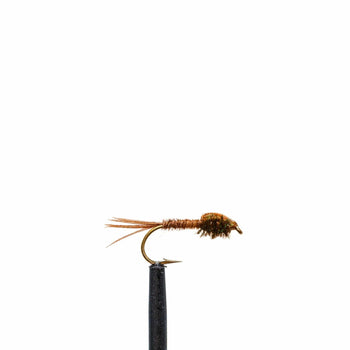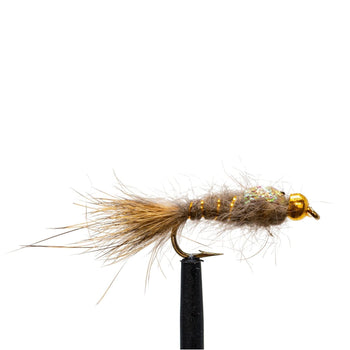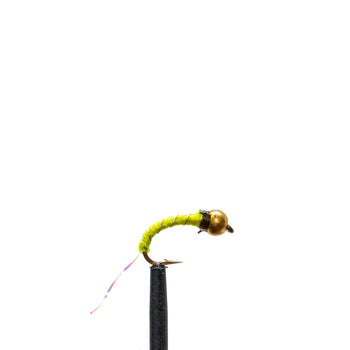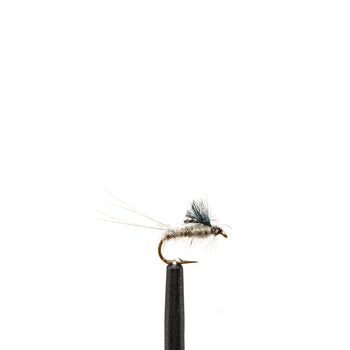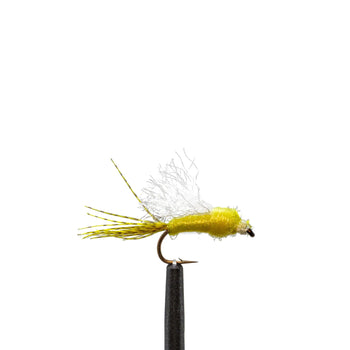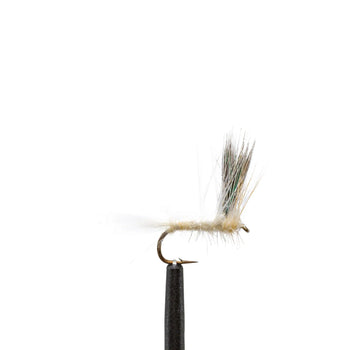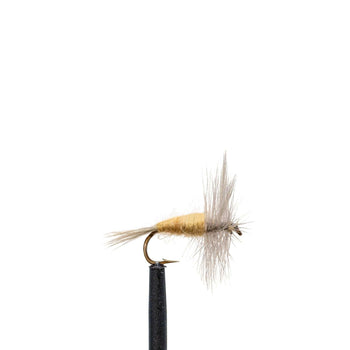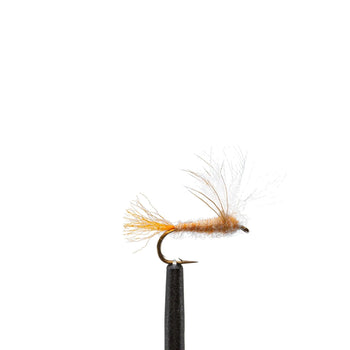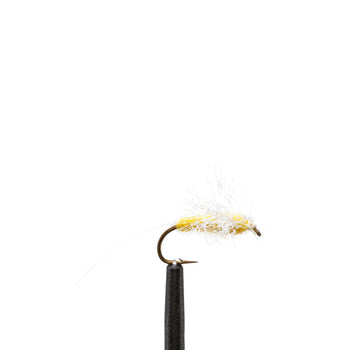Fly of the Month: The Pale Morning Dun (PMD) – Tactics for Every Stage of the Hatch from Nymph to Spinner

Few hatches inspire more excitement among trout anglers than the Pale Morning Dun. With its long emergence windows, prolific presence in Western rivers, and the technical but rewarding fishing it creates, the PMD has earned its place as one of the most beloved mayflies in the sport. This month, we’re celebrating the PMD hatch—exploring its background, how to identify it, and, most importantly, how to fish it.
What is a PMD? (And Why It Matters)
The Pale Morning Dun (Ephemerella inermis and E. excrucians) is a species of mayfly commonly found in freestone and tailwater rivers throughout the Western U.S. Though "pale" is in the name, PMDs range from creamy yellow to olive, with distinct pink or tan undertones. These mayflies are typically size 14–18, and emerge steadily from late spring through summer, depending on elevation and water temperature.
PMD hatches are consistent and long-lasting, often bringing fish to the surface day after day. Because trout can become selective during these hatches, having the right fly—and knowing how to present it—can make all the difference.
The PMD Lifecycle and Its Importance to Anglers
The Pale Morning Dun mayfly has a one-year life cycle, starting as a nymph on the riverbed and evolving through various stages including emerger, dun, and spinner. Nymphs mature and emerge as duns, which then become winged adults. After a day or two, duns transform into spinners, which mate and lay eggs before dying, completing the cycle.

Understanding this lifecycle helps anglers choose the right pattern and presentation. Like all mayflies, PMDs go through four stages: egg, nymph, emerger, and adult. Trout feed during three of these phases—nymph, emerger, and adult—offering multiple opportunities to match the hatch throughout the day.
-
Eggs: Fertilized by the spinner stage, eggs sink and adhere to rocks or vegetation on the streambed.
-
Nymph Stage: PMDs spend most of their lives underwater as nymphs, crawling along the streambed. Trout key in on this stage in the hours before a hatch begins.
-
Emerger Stage: As the nymphs ascend to the surface to emerge, they become vulnerable and are often targeted by trout just below or in the surface film.
-
Adult (Dun) Stage: Once emerged, adult PMDs ride the current for several moments as they dry their wings. This is when classic dry fly action takes off.
-
Dun molts into Spinner: After 24–48 hours, duns molt into spinners with outstretched wings.
-
Spinner deposits eggs: Spinners return to the water to mate and lay eggs in calm eddies or slow current.
- Spent Spinner: After egg-laying, the spinners die and float downstream, becoming easy prey for trout.
By timing your fly choice with these stages—starting with nymphs early, switching to emergers mid-hatch, and finishing with dries or spinners—you’ll increase your odds of success dramatically.
A Brief History of PMDs in Fly Fishing
Pale Morning Duns rose to fame in the 20th century as anglers in Montana, Wyoming, and Idaho began documenting the reliable midday hatches that turned quiet runs into dry fly playgrounds. The term "PMD" became shorthand for a wide range of light-colored mayflies that appeared late in the morning and brought fish to the surface for hours.
Iconic rivers like the Henry’s Fork, Madison, and Firehole helped cement the PMD’s status in fly fishing lore. These hatches rewarded technical casting and fly choice, leading to the development of many PMD-specific patterns that are still used today.

How to Fish the PMD Hatch
PMD hatches are often complex, involving three key stages: nymphs, emergers, and adults. Each stage can produce feeding behavior in trout, and success often requires matching the behavior and phase of the hatch.
- Start with a nymph: Before the hatch, fish a PMD nymph low and slow. Use patterns like a Beadhead Flashback Pheasant Tail or PMD Nymph with light split shot and a dead-drift presentation.
- Switch to an emerger: As fish begin rising but don’t take on the surface, try a PMD emerger or soft hackle fished just below the film.
- Go dry: When trout begin sipping duns off the surface, it’s time for the dry fly. Focus on accurate drifts with long leaders and light tippet to avoid spooking wary fish.
Top PMD Fly Patterns (By Stage)
Here are some of our favorite fly patterns for matching the PMD hatch, whether you’re fishing in the Rockies or a local tailwater:
Nymphs: Imitating the Subsurface Stage
Before PMDs hatch, trout feed aggressively on their nymphs near the bottom. These patterns should be fished deep on a dead drift with split shot or under an indicator. A two-fly rig with a beadhead nymph and emerger is especially effective leading up to the hatch.
Pheasant Tail Nymph (Sizes 14–18): A legendary nymph with a natural taper and just enough flash to imitate a wide range of mayfly nymphs. Deadly on its own or as part of a two-fly rig.
Gold-Ribbed Hare’s Ear (Sizes 14–18): A versatile, buggy pattern with a lifelike appearance that mimics many mayfly species. Great for prospecting or when fish are not dialed in on a specific nymph.
Beadhead Hare’s Ear Flashback (Sizes 14–18): Adds weight and flash to the traditional profile, making it perfect for stained water or overcast days when extra visibility matters.
Zebra Midge – Chartreuse (Sizes 18–22): A simple but effective pattern that excels early in the hatch or in tailwaters where midges and PMDs overlap. Fish it deep with light tippet and a slow drift.
📌 Pro Tip: Fish nymphs early and adjust weight as needed. A small indicator or tight-line setup helps detect subtle strikes in the early stages of a hatch.
Emergers & Soft Hackles: Targeting the Transition Phase
When trout are feeding just below the surface, emerger and soft hackle patterns shine. These flies imitate PMDs as they struggle to escape their nymphal shucks or drift vulnerable in the film. Fish them just under the surface on a dead drift or swing them through riffles and seams.
Beadhead PMD Emerger (Sizes 16–18): Imitates a PMD nymph struggling to emerge. The beadhead provides just enough weight to keep it in the film, making it deadly in slow seams and behind rising fish.
RS2 (Sizes 18–22): A classic emerger pattern for technical hatches. Its slim profile and trailing shuck make it deadly when fish are ignoring duns.
Beadhead Soft Hackle Flash Pheasant Tail (Sizes 14–18): Combines the buggy silhouette of a pheasant tail with soft hackle movement and beadhead weight. Excellent for swinging or dead drifting just below the surface when trout are targeting emergers.
Yellow Emerger (Sizes 16–18): A lightly dressed pattern with a yellow body and CDC wing. Imitates a freshly emerged PMD caught in the surface film. Best fished in slower currents or slicks.
📌 Pro Tip: Emergers often outperform dries when trout are picky. Swing soft hackles through riffles or fish beneath an indicator when you see bulging rises but no takes on top.
Dry Flies: Matching the Adult Stage
These patterns imitate the fully emerged dun—a mayfly floating on the surface with upright wings. PMD dry flies are most effective during the height of the hatch when trout are rising visibly. Present with a drag-free drift, using long leaders and light tippet in clear seams or riffles.
PMD Parachute (Sizes 14–18): A high-floating dry with upright post and hackle for visibility in riffled water. Best used during the peak of the hatch when fish are targeting adult duns on top.
Pale Morning Dun (PMD) (Sizes 14–18): A traditional upright-wing PMD imitation that floats cleanly on the surface. Excellent for matching the adult stage when fish are confidently rising. Fish it alone with a drag-free drift over rising trout in clear seams and pools.
Sparkle Dun (Sizes 14–18): A flush-floating emerger pattern that imitates freshly emerged duns struggling to break through the surface. Perfect for calm water or over picky trout during the early stages of the hatch.
PMD Spinner (Sizes 16–18): A classic spent-wing pattern with low profile and outstretched wings. Most effective in the evenings and on flat water when spent duns collect in back eddies and slicks.
📌 Pro Tip: Carry a variety of PMD dries—from flush-riding Sparkle Duns to classic upright-wing patterns—to match water conditions and fish preferences. Fish are often more willing to rise when your fly is easy to track and rides naturally in the current.
Pro Tips for PMD Success
- Fish early and late: While the name suggests morning, PMDs can hatch throughout the day. Be ready before the hatch and stay after for spinner falls.
- Use fluorocarbon tippet: Lighter 5X–6X helps reduce drag and makes a more natural presentation.
- Target the seams: PMDs often emerge in softer edges or riffles. Don’t waste time in fast, deep runs.
- Observe carefully: Watch rise forms to decide if trout are feeding on emergers or duns—then adjust your pattern accordingly.
Whether you're chasing picky risers on a spring creek or prospecting riffles on a freestone river, the PMD hatch offers dry fly fishing at its finest. With the right flies, timing, and presentation, you’ll find yourself in the middle of one of the most dependable and rewarding hatches of the season.
Explore Our Mayfly Life Stages Collection
Related Articles:
- Fly of the Month: The Blue-Winged Olive (BWO)
- Match the Spring Hatch: Top 10 May Hatches Every Fly Angler Should Know
- The Ultimate Spring Fly Fishing Guide: Tactics, Hatches & Flies for Success
- Conquer Spring Runoff: Fly Fishing Tactics That Work


